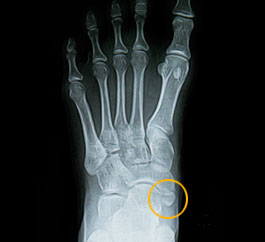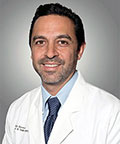- Home
- Foot & Ankle Conditions
- Pediatric Conditions
- Accessory Navicular
Accessory Navicular: causes, symptoms and treatment

What is an accessory navicular?
The accessory navicular (os tibiale externum) is an extra piece of cartilage or bone located midfoot just above the arch on the inside of the foot.
This ossicle (extra bone) is usually encased in the posterior tibial tendon, which attaches the foot's inside (medial) arch to the calf muscle. Accessory navicular is commonly seen in pediatric patients.
Most people do not have an accessory navicular. People who do have one are born with this condition and may go their whole lives without realizing it. Others will experience pain and foot deformities.
- Why does an accessory navicular require bone treatment?
- What are the symptoms of accessory navicular syndrome?
- How is accessory navicular syndrome diagnosed?
- What are accessory navicular treatment options?
- What is accessory navicular bone surgery?
- University Foot & Ankle Institute is ideal for accessory navicular treatment
-
Foot and Ankle Surgeon and Director of University Foot and Ankle Institute
Dr. Bob Baravaria DPM, FACFAS is a Board-Certified Podiatric Foot and Ankle Specialist. He is an assistant clinical professor at the UCLA School of Medicine and serves as Director of University Foot and Ankle Institute.
Dr. Baravarian has been involved in athletics his entire life and played competitive tennis in high school and college. He has an interest in sports medicine, arthritis therapy, and trauma/reconstructive surgery of the foot and ankle. He is also fluent in five languages (English, French, Spanish, Farsi, and Hebrew),
 Dr. Franson was very professional and friendly. I would definitely recommend him.Sherry G.
Dr. Franson was very professional and friendly. I would definitely recommend him.Sherry G. Great experience. Great communication. Great direction for my care. Very happy I chose to go with this particular doctor and o...Christopher R.
Great experience. Great communication. Great direction for my care. Very happy I chose to go with this particular doctor and o...Christopher R. Great service and care. Highly recommend Dr. Franson.David B.
Great service and care. Highly recommend Dr. Franson.David B. If you have to go see a Doctor than this is a great experience.Frank M.
If you have to go see a Doctor than this is a great experience.Frank M. My doctor was great. Really greatRudolph B.
My doctor was great. Really greatRudolph B. I am a diabetic. I dropped a 2 drawer metal file cabinet on my big toe. Due to the diabetes I knew I had to have it checked o...Darcy T.
I am a diabetic. I dropped a 2 drawer metal file cabinet on my big toe. Due to the diabetes I knew I had to have it checked o...Darcy T. Good.David E.
Good.David E. Your Santa Barbara office and Dr. Johnson always give me excellent care!Jayne A.
Your Santa Barbara office and Dr. Johnson always give me excellent care!Jayne A. Dr. Gina Nalbadian was amazing!! I came in with an emergency foot situation and she had wonderful bedside manner and resolved m...Danielle C.
Dr. Gina Nalbadian was amazing!! I came in with an emergency foot situation and she had wonderful bedside manner and resolved m...Danielle C. I was frustrated that after 3 weeks I still hadn’t heard back about my PT referral status. And I did sit in a room for over 30 ...Sarah C.
I was frustrated that after 3 weeks I still hadn’t heard back about my PT referral status. And I did sit in a room for over 30 ...Sarah C. I’m very pleased with Dr. Kelman.Alan S.
I’m very pleased with Dr. Kelman.Alan S. Great care....Been going here for years!Mary B.
Great care....Been going here for years!Mary B.
